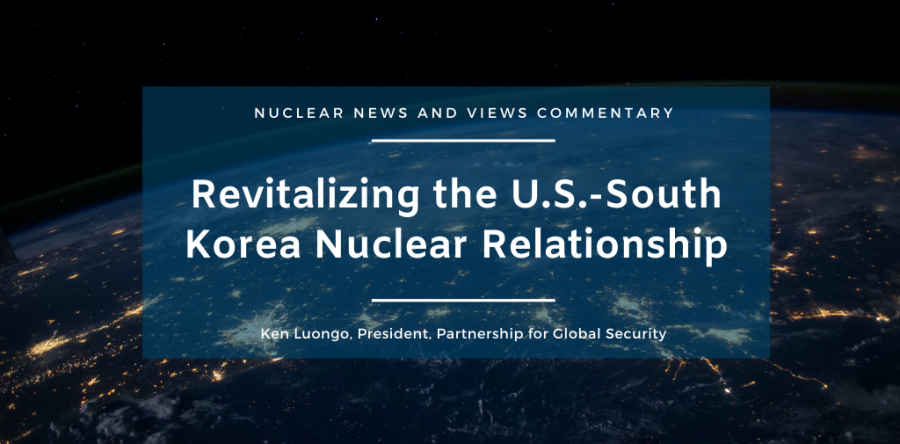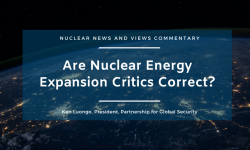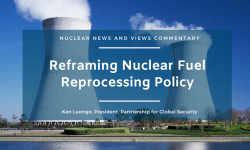The first summit between South Korea’s new President, Suk-yeol Yoon, and U.S. President, Joe Biden, is reported to feature new agreements on nuclear energy collaboration as part of an expansion of high-technology cooperation. The question is whether these new nuclear commitments will yield more than a passing press release.
It has been a year since Biden and Korea’s previous President, Jae-in Moon, met in Washington and agreed to expand their nation’s civil nuclear cooperation.
In a joint statement from that summit, the countries committed to “develop cooperation in overseas nuclear markets, including joint participation in nuclear power plant projects.” A summit fact sheet committed the leaders to “promote coordination in the supply chain” to support collaboration in overseas nuclear markets. South Korea also agreed to “adopt a common policy with the United States to require recipient countries have an IAEA safeguard agreement Additional Protocol in place as a condition of supply of nuclear power plants.”
Since that event, little progress has been made on any of these commitments and old problems that have plagued the U.S.-Korea civil nuclear relationship remain unresolved.
The Biden-Yoon summit may codify bilateral collaboration on small modular reactors, but that is low hanging fruit. Major Korean companies, including Samsung and Doosan, have already signed agreements to work with America’s NuScale to build small modular reactors (SMRs). And Korea’s SK Inc. has signed an agreement with TerraPower.
The presidents also may agree to resurrect the High-Level Bilateral Commission (HLBC), a consultative group that has been moribund as a result of a festering intellectual property dispute between two nuclear companies, Westinghouse and KEPCO, that dates back to the middle of the Trump administration. But even when the HLBC was operational, its results were meager.
What could change the calculus for both countries are two key issues – the rising importance of nuclear power for carbon reduction and energy security and Russia’s crippling of its nuclear export preeminence as a result of its disastrous invasion of Ukraine. These are major changes in the international environment, and they create new opportunities for serious collaboration.
If the U.S. and Korea are going to reboot their nuclear energy relationship, they will need to move beyond the summit rhetoric and take specific and difficult actions in three vital areas.
First, in the area of civil nuclear cooperation, the essential objective is to resolve the Westinghouse-KEPCO dispute. Numerous discussions have occurred at working levels without result. Moon did not want to get involved in the fight. Yoon can’t continue that vacillation. Without resolution of this issue, U.S.-Korea collaboration on large reactor projects won’t happen and suspended technical-level engagement won’t resume.
The revival of the HLBC also is necessary, but so is the expansion of its remit. The original forum was designed for a different era. At the very least, it needs to include two additional tracks. One focusing on nuclear investment to mobilize capital on the scale required to achieve the nuclear growth goals of both nations. The second tasking non-governmental experts to generate new ideas and analyses for government consideration.
Second, if the U.S. and Korea prove themselves capable of rapidly removing the self-inflicted roadblocks to their nuclear collaboration, then they may be ready to respond to the opportunities arising in international nuclear exports and geopolitics.
While Russia may remain a force in international nuclear commerce, its days as the global leader are over – for now. The U.S. and Korea should have two overriding goals in this new environment - position themselves as reliable nuclear exporters that support the highest levels of nuclear governance and prevent China from filling the gap left by Russia’s nuclear export implosion.
To achieve these goals, they should take several actions this year. First, convene commercial and government officials to identify the opportunities for bilateral nuclear export and collaboration in third countries. This discussion should target opportunities, assess supply chain issues, and identify the strengths and weaknesses of each country in nuclear export. Second, identify how to create collaborative financing for third country reactor exports and equitable mechanisms for profit sharing. Third, identify the research and test capabilities required to support next-generation advanced nuclear power technologies that can replace facilities in Russia or China.
Third, implementing the commitment to cooperate on nuclear export requires both nations to remain at the pinnacle of international nuclear governance for existing and future technologies. Effective nuclear nonproliferation and security norms are essential international guardrails for the civil use of nuclear energy.
The most challenging task for the two nations will be identifying the mechanisms by which the Additional Protocol will be implemented in joint projects in third countries. Moon’s commitment to the AP has not been popular in South Korea because of concerns about its impact on Korea’s reactor competitiveness. It is an important issue that will test the young Yoon administration.
Easier collaborations can occur in two other areas. One is cooperation on the “By Design” process of incorporating safeguards and security improvements for novel fuel cycle advanced reactors. The second is preparing new nuclear nations for the deployment of reactor technologies. Many potential purchasers of smaller reactors require a robust support system to ensure that the technologies can be safely and security operated. The reactor exporters may need to supplement IAEA activities.
The international political and energy environment has changed substantially and quickly over the past year. The Yoon-Biden summit is an opportunity to prove that revitalized U.S.-Korea civil nuclear cooperation is an imperative for both nations. But, realizing that commitment will require much more than summit statements.
Ken Luongo, President, Partnership for Global Security





